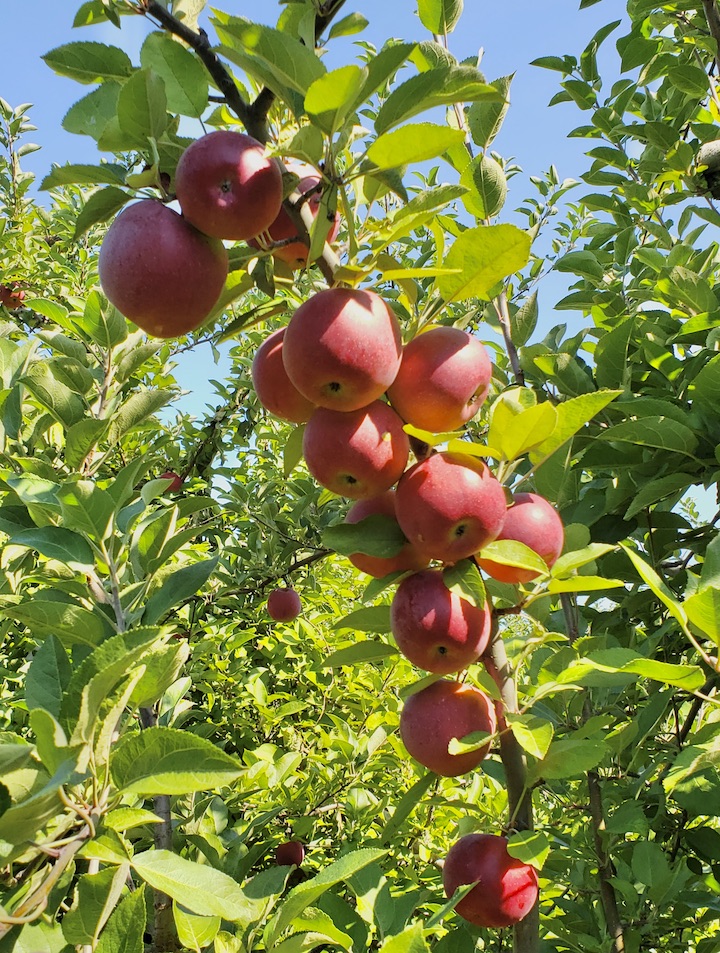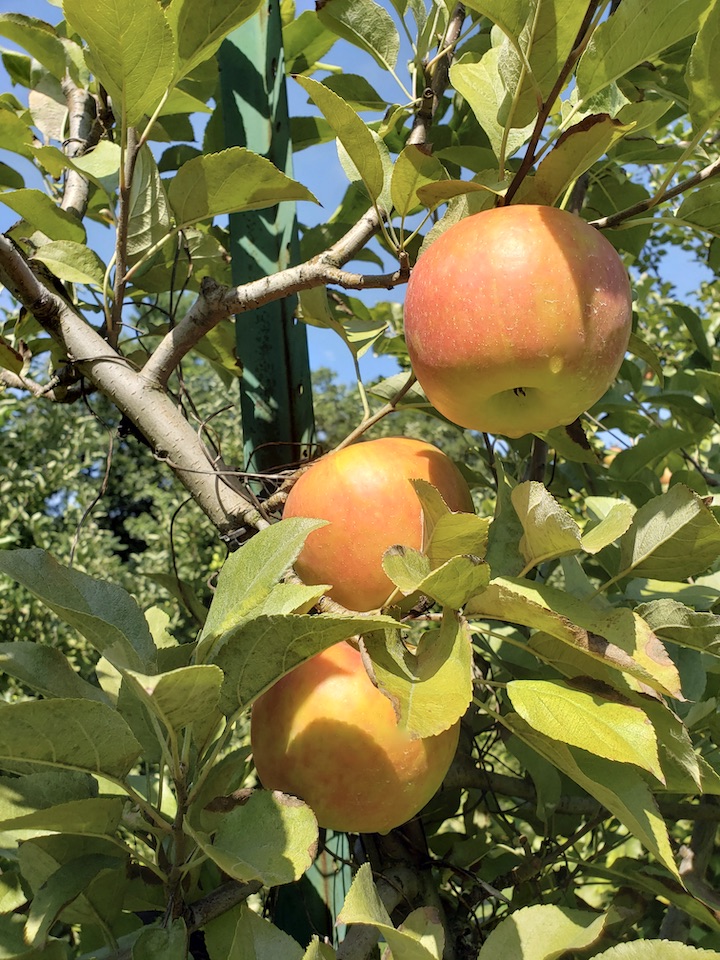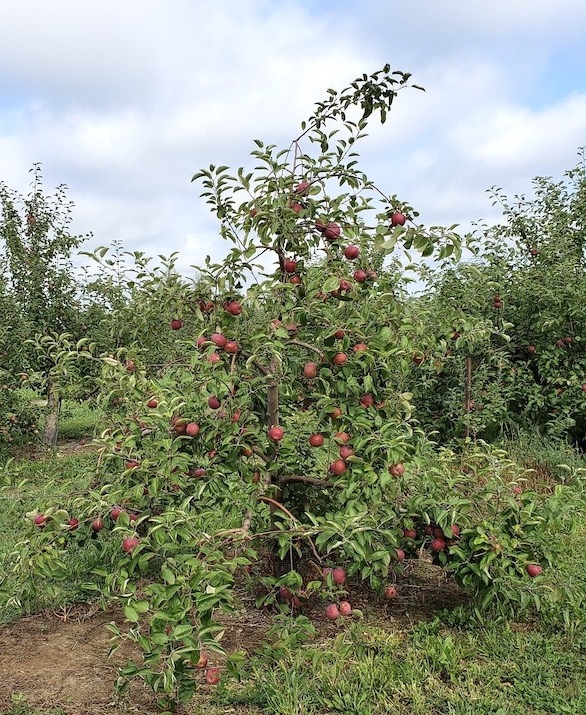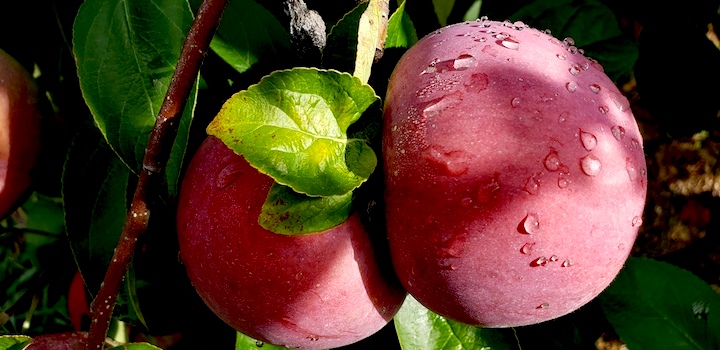
ONE OF THE MOST AMAZING things about the apple is how it connects us to our past.
A history book, a photograph or painting, an ancient manuscript or building enable us to imagine what life was like a century or more ago. The apple supplies the real thing.

That’s because true varieties are propagated by grafting rather than by seed. A small branch or cutting is taken from the desired variety and attached to a “rootstock” (the base of another apple tree chosen for hardiness, disease-resistance, or some other horticultural trait), and thereafter the apples on that tree will always be the grafted variety.
It is not the only fruit grown this way — oranges are another — but due to its diversity in flavor, color, size, and origin, the apple gives us a literal taste of what life was like in a different time or place. Every apple is a direct descendant of its original tree!
Whether it is Baldwin (Wilmington, Massachusetts, 1741), Black Oxford (Maine, 1790), Roxbury Russet (Roxbury, Massachusetts, 1635), or Sheep’s Nose (Connecticut, 1700s), or old European apples like Calville Blanc d’Hiver (1500s), Gravenstein (1600s), or Lady (1600s), our apples are living history.

WHICH BRINGS US to the most prolific apple of all time: McIntosh.
Since the original tree discovered on the family farm in 1801 Dundas County, Ontario, gave McIntosh its name, no apple has had a greater influence on the world’s apple-eating habits.
It took awhile. The first McIntosh trees did not arrive in the United States until 1868, in Vermont. Its popularity grew slowly but steadily until the winter of 1934-35, when New England’s dominant variety at the time, Baldwin, was devastated by severe cold. Rather than replant Baldwins, the region’s apple growers opted for the hardier, more reliable McIntosh, and it has been New England’s most popular apple ever since.
But that is only part of the story. McIntosh’s influence is found as a parent to other apples. Even at the time of its ascension, McIntosh had already given birth to mid-season varieties Cortland (an 1898 cross with Ben Davis) and Macoun (a 1909 cross of McIntosh with Jersey Black).
Since then, McIntosh has contributed to a cluster of early season apples like Early Mac, Jersey Mac, Jonamac, Marshall Mac, Pioneer Mac, and RubyMac, and later in the season, Empire.
The main reason is flavor. McIntosh’s distinctive sweet-tart taste is synonymous with apple flavor, lending an irresistible tang to almost any apple. Empire, a 1945 cross of McIntosh with Red Delicious, is a perfect example. The Mac lends complex flavor and juiciness to Red Delicious’s bland sweetness, resulting in an outstanding variety.
At many New England orchards, this weekend marks the beginning of the real thing: McIntosh in its purest form. When you bite into that juicy, aromatic, sweet-tart flesh, know that you are experiencing the same thrill that John McIntosh felt on his farm in Canada when tasting the first McIntosh more than 200 years ago.

As always, consult our Orchard Finder to learn more about our finest orchards, and call ahead to see what’s picking.
***

Here’s a delicious pairing of McIntosh apples and Cheddar cheese. If the Macs aren’t ready, early season apples like Ginger Gold will do.
Apple McIntosh and Cheese
APPLES AND CHEDDAR are no strangers to one another. Cheddar cheese with apple pie is a New England tradition. A piece of sharp, savory cheese paired with a slice of fresh, sweet apple, or broiled on a piece of sourdough bread with onion and mustard is a gustatory pleasure.
McIntosh is the obvious choice for the apple in this recipe, not just for the play on words but because it has the right sweet-tart flavor to contrast with the cheese’s savory sharpness. The pieces of McIntosh provide a creamy texture distinct from both sauce and pasta. A denser apple like Cortland requires more baking time to cook completely.
Whole wheat pasta packs a more nutritional punch than the traditional processed kind, and it is more substantial, so a smaller portion suffices. I appreciate whole wheat pasta’s rich, nutty flavor, too, although when covered in cheese sauce it is indistinguishable from the plain white stuff.
For breadcrumbs we cubed 8 slices of a hearty oatmeal bread and sautéed it in a stick of butter until browned. It made a spectacular topping.
1 12-oz. box rotini or other whole grain pasta
2 New England McIntosh apples, cored and diced (3-4 c)
3 T butter
6 cloves garlic, finely chopped
3 T flour
2½ c milk
1 bay leaf
3 c sharp cheddar cheese, grated
1 T dry sherry
salt and pepper to taste
2-3 c breadcrumbs, sautéed in one stick melted butter
Preheat oven to 350°F. Butter a 3-quart casserole.
Boil pasta in a large saucepan according to directions. Drain and return pasta to saucepan. Add diced apples.
Meanwhile, melt butter in medium saucepan. Add garlic and cook 3 minutes or until tender. Stir in flour; cook 1 minute.
Add milk, bringing to a gentle simmer and whisking constantly. Add bay leaf. Reduce heat to low and cook sauce for 10 more minutes, stirring often.
Discard bay leaf. Add 2½ cups cheese and the sherry, and cook until cheese is melted. Remove from heat; season to taste with salt and pepper.
Pour cheese sauce into pasta-apple mixture, and transfer mixture to prepared casserole. Sprinkle with remaining ½ cup cheese and top with sautéed breadcrumbs.
Bake, uncovered, 30 minutes until golden brown. Let stand 5 minutes before serving.
2 Comments
Leslie Mason
Fascinating Russ! And here I thought I knew a lot about Macs having worked with you on the videos. Simply gorgeous pictures. How I wish we were off at dawn to an orchard to record a new series of videos! Wonder if the Big E is happening, I haven’t looked it up. What a refreshing piece to read this morning as the world gets worse by the moment. Be safe and well! And I’ll try the McIntosh and Cheese.
Russell Powell
Thanks so much, Leslie! Alas, no Big E this year. In some ways we will miss it, but we were also relieved. Let’s hope for more apple videos in our future. What fun!